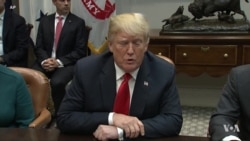China says it has no choice but to retaliate to U.S. President Donald Trump's 10 percent tariffs on $200 billion in Chinese goods, risking a further escalation of trade tensions between the world’s two biggest economies.
On Tuesday, China announced a tariff hike on $60 billion of American products.
In a brief statement posted online Tuesday, China’s Commerce Ministry said, "To protect its legitimate rights and interests and order in international free trade, China is left with no choice but to retaliate simultaneously."
WATCH: Trump's Trade Spat With China Gets Limited Support from Lawmakers
On Monday, the Communist Party backed Global Times newspaper warned that if Trump went ahead with the tariffs, China would not just play defense.
At about the same time the Commerce Ministry statement was released, a research director for North America and the Pacific at the Commerce Ministry also delivered a commentary on China’s state-run CCTV news network.
The official said the latest round of tariffs have brought uncertainty to ongoing efforts for representatives from both countries to meet again and hold trade talks.
“Under the party’s strong central leadership, China has the resolve and confidence to press ahead and use deeper reforms and deeper opening up as well as the development of our domestic market to counter United States unilateralism,” Li Wei said.
Foreign Ministry spokesman Geng Shuang told a daily briefing Tuesday in Beijing that talks are the only correct way to resolve the issue and accused the United States of being insincere. Last week, the United States extended an invitation to China’s top negotiator, Liu He, to resume talks later this month in Washington.
The $200 billion in U.S. tariffs go into effect in less than a week, on September 24, leaving the two sides little time to sit down.
On Monday, President Trump warned, in a statement announcing his move, if China retaliates against U.S. farmers or other industries, Washington “will immediately pursue phase three, which is tariffs on approximately $267 billion in additional imports."
The additional $267 billion in tariffs is expected to cover all Chinese imports to the United States.
American and European businesses operating in China say that if Washington presses ahead with more and more tariffs, it is likely to only add to the challenges businesses are already facing.
According to surveys conducted by the American Chamber of Commerce in China and the European Chamber of Commerce, trade tensions are already hitting and hurting supply chains of foreign businesses. Some companies have begun to move manufacturing away from China and the United States to avoid the impact of growing trade tensions, the European Chamber said.
European Chamber President Mats Harborn said engagement on the part of Washington and Beijing is the answer.
He said that what the United States is doing now is “economic madness” that risks creating a vicious cycle for business that could have an impact in China and elsewhere. But the root of the trade dispute is that China’s reform is lagging behind its development, creating a “reform deficit.”
“Closing the reform gap will create better private companies in China, foreign companies,” Harborn said. “And reducing the reform deficit should also help reduce tensions in the ongoing trade war.”
In its annual position paper on European business in China, the chamber lists 828 recommendations for Chinese authorities to address that deficit.
One of the key hurdles both private Chinese enterprises and foreign companies face is the dominant position state owned enterprises (SOEs) enjoy. State owned enterprises account for around 30 percent of the economy and yet enjoy nearly 70 percent of all financing, the report said.
Unfair trade practices and the way SOEs contribute to an unbalanced playing field in China are key elements of the investigation the Trump administration carried out prior to launching its first round of tariffs.
But how far China is willing to go to change is uncertain. Later this month, a meeting on SOEs will be held that many are expecting will be an indicator of the future course China’s Communist Party leaders plan to chart.
“We hear that there is a move to make the SOEs stronger, bigger and better,” Harborn said. “Such ambitions are hindering the further opening and development of the vibrant private Chinese sector.”
If reform of SOEs is not on the agenda at the meeting, that would be seen as a clear provocation, given the current climate, he said.











